Module 4: The Spheres Supporting Life
Atmosphere
Definition: A layer of gas that envelopes the planet and is held in place by the Earth’s gravity
Gas Composition of the Atmosphere
78% Nitrogen (N2)
21% Oxygen (O2)
~1% Water Vapor
Trace Amounts of Argon (Ar), Carbon Dioxide (CO2), and Aerosols
Layers of the Atmosphere
General Characteristics of Atmosphere Layers
Differentiator: Changes in Temperature, Absorption Rate of Solar Energy
Range: Altitude and the Earth’s Spherical Shape
Troposphere
The lowest layer of our atmosphere, where life and weather occurrences occur
From ground level to at least 10 kilometers above sea level
↑ Altitude → ↓ Air Pressure & ↓ Temperature
Stratosphere
From 10 kilometers to 50 kilometers above sea level
Presence of the ozone layer and jet streams
↑ Altitude → ↑ Temperature
Mesosphere
From 50 kilometers to 85 kilometers above sea level
Region where most meteors start to burn
↑ Altitude → ↓ Air Pressure & ↓ Temperature
Ionosphere
Region within the Mesosphere and the Thermosphere
Solar Radiation knocks electrons loose, charging them into ions
Thermosphere
One of the topmost layers of our atmosphere
From 85 kilometers to 500–1000 kilometers above sea level
Region where satellites are present
↑ Altitude → ↓ Air Pressure & ↑ “Temperature” (“Cold”)
Exosphere
One of the topmost layers of our atmosphere, the “final frontier”
From 100k to 190k kilometers above sea level
↑ Altitude → ↓ Air Pressure
Air Pollutants
Definition: A mix of particles and gases which, upon reaching harmful concentrations, increase risk of disease and heighten temperatures
Sources of Air Pollution
Natural Air Pollutants
Sources: Dust blown by wind, pollutants from wildfires and volcanic eruptions, and volatile organic chemicals released by some plants
Primarily spread out throughout the globe or removed by natural processes (chemical cycles, precipitation, gravity)
Artificial Air Pollutants
Sources:
Stationary Sources: Burning of Fossil Fuels, Industrial Plants
Mobile Sources: Gasoline/Diesel Fuel in Cars
Concentrated in industrial and/or urban areas
Primary and Secondary Pollutants
Primary Pollutants: Harmful chemicals emitted directly into the air from natural processes and human activities
Secondary Pollutants: Primary pollutants reacting with one another or with the basic components of air to form new harmful chemicals
Major Air Pollutants
Carbon Oxides (CO/2)
Colorless, odorless, and potentially toxic gases contributing to climate change
Sources: Motor vehicle exhaust, clearing and burning of forests and grasslands, inefficient cooking practices, burning of fossil fuels, etc.
Nitrogen Oxides (NO/2), Nitrous Oxide (N2O) & Nitric Acid (HNO3)
Chemicals responsible for harmful acid deposition and irritation of respiratory + integumentary system
Sources: coal-burning power plants, high-temperature automobiles, lightning & select bacteria (nitrogen cycle), fertilizers and animal wastes
Creates photochemical smog, a chemical mixture formed due to sunlight in cities with heavy traffic
Sulfur Dioxide (SO2) and Sulfuric Acid (H2SO4)
Components of acid rain, they aggravate physical ailments, damage flora and fauna, and corrode materials
Sources: one-third sulfur cycle, two-thirds due to combustion of sulfuric containing materials and processes
Suspended Particulate Matter (SPM)
Catch-all term for toxic solid particles and liquid droplets small and light enough to remain suspended in the air for long periods
Sources: 62% Natural (dust, wildfires, and sea salt), 38% Artificial (plowed fields, road construction, unpaved roads, tobacco smoke, coal-burning electric power and industrial plants, and motor vehicles)
Ozone (O3)
A colorless and highly reactive gas serving as a component for photochemical smog
Aggravates respiratory and circulatory disease, damages plants, rubbers, tires, paints
Volatile Organic Compounds
Organic compounds existing as gases in the atmosphere, primarily hydrocarbons
Sources: one-third from natural sources (plants, wetlands, and termites), two-thirds from artificial sources (rice paddies, landfills, and oil and natural gas wells)
Mostly serves as components for various industrial products
Global Warming & Climate Change
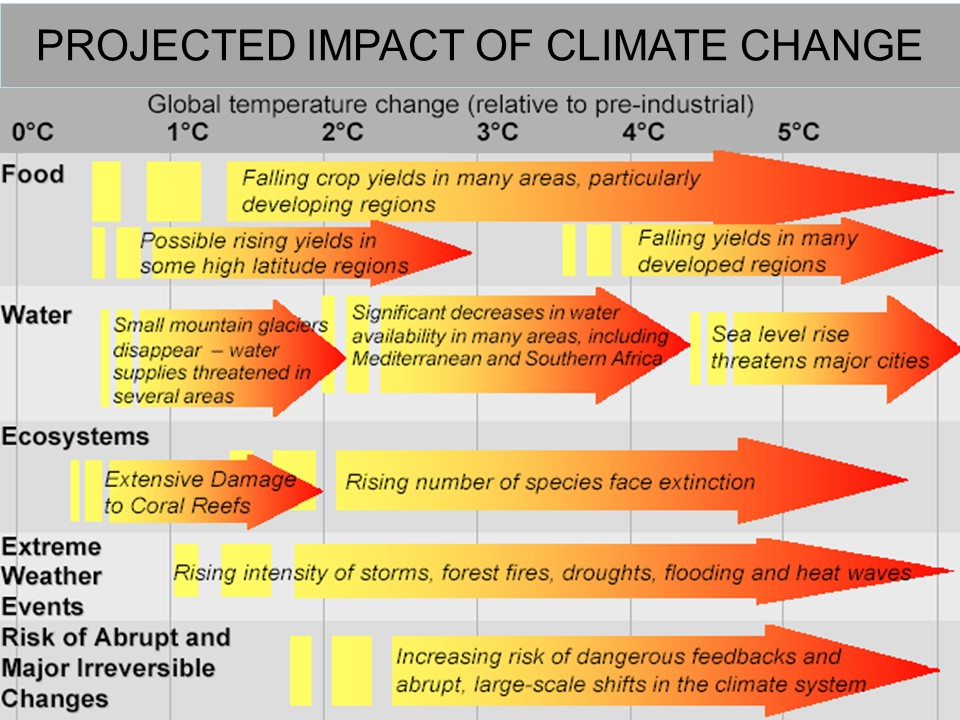
Hydrosphere
Composition of the Hydrosphere
71% of the Earth’s surface is covered in water
2.5% freshwater
1% readily available, consumable freshwater
Water/Hydrologic Cycle
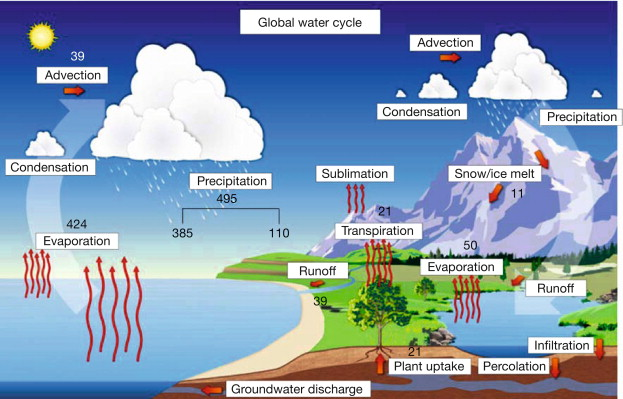
Surface water and groundwater are highly connected
The movement of water in the sea, in the air, and on land, which is driven by solar energy and gravity
Main Water Resources
Groundwater
Key Characteristics
The most important source of water
It fills the spaces between soil particles and fractured rock beneath the earth’s surface
Parts of Groundwater
Zone of Saturation (Zone of soil and rock saturated with water)
Water Table (Top of the groundwater)
Aquifers
Unconfined Aquifer (water seeps from the ground surface directly above the aquifer)
Confined Aquifer (layers of impermeable material are both above and below the aquifer)
Surface Water (Rivers and Watershed)
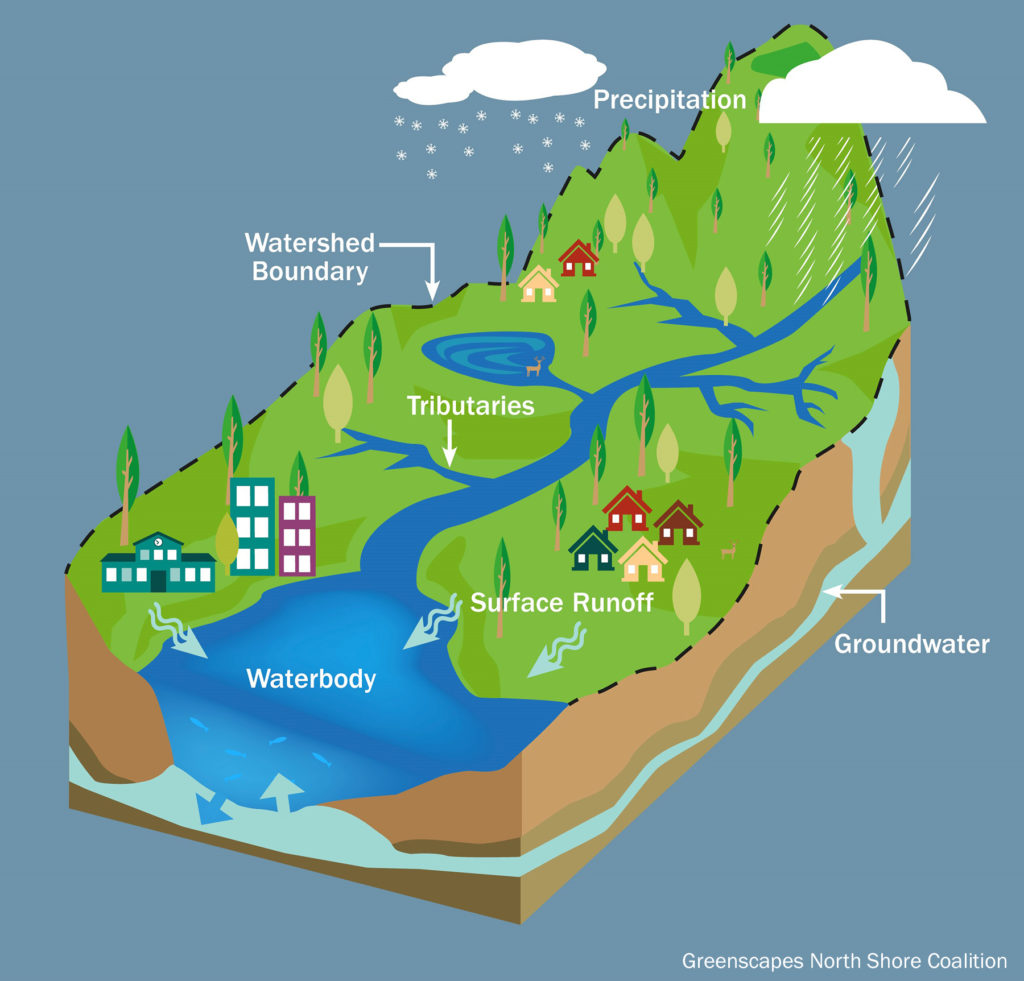
Watersheds or drainage basins are an area of land that contributes water to a particular stream of river
The boundary of a watershed is called a drainage divide
Surface and Groundwater Pollution
Defining Water Pollution
One of the main threats to our water resources
Can be measured by biological (fecal coliform), chemical (N-P-K), or physical (sedimentation) criteria
Types of Water Pollutants/Sources
Point Sources
Pollutants are discharged at specific locations, such as drain pipes, ditches, or sewer lines into bodies of water
Traditionally easy to identify, monitor, and regulate (dependent on the economic resources of a country)
Examples: Factories, sewage treatment plants, underground mines, and oil tankers
Non-Point Sources
Pollutants are scattered and diffuse and cannot be traced to any single site of discharge
Significantly harder to identify, monitor, and regulate
Examples: Runoff of chemicals and sediments into surface water from cropland, livestock feedlots, logged forests, urban streets, lawns, and golf courses
Types of Water Pollution
Lotic/Standing Water Pollution (Difficult to dilute and discharge pollutants due to weak flow and stratified layers of water)
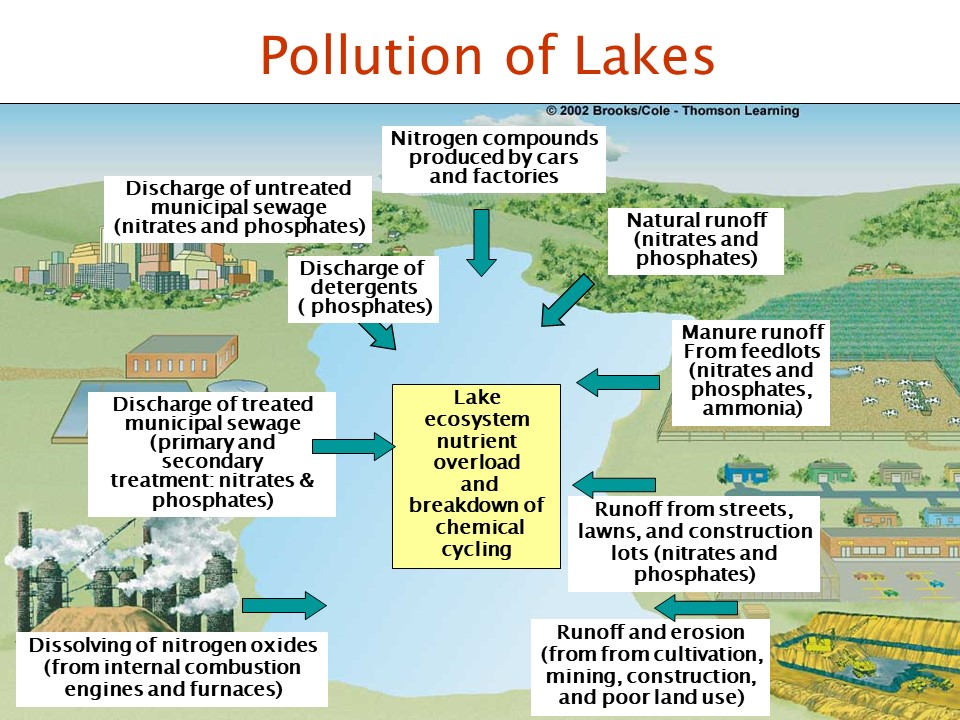
Lentic/Running Water Pollution (Can rapidly recover from pollutants due to dilution, biodegradation, and bacterial presence breaking down wastes)
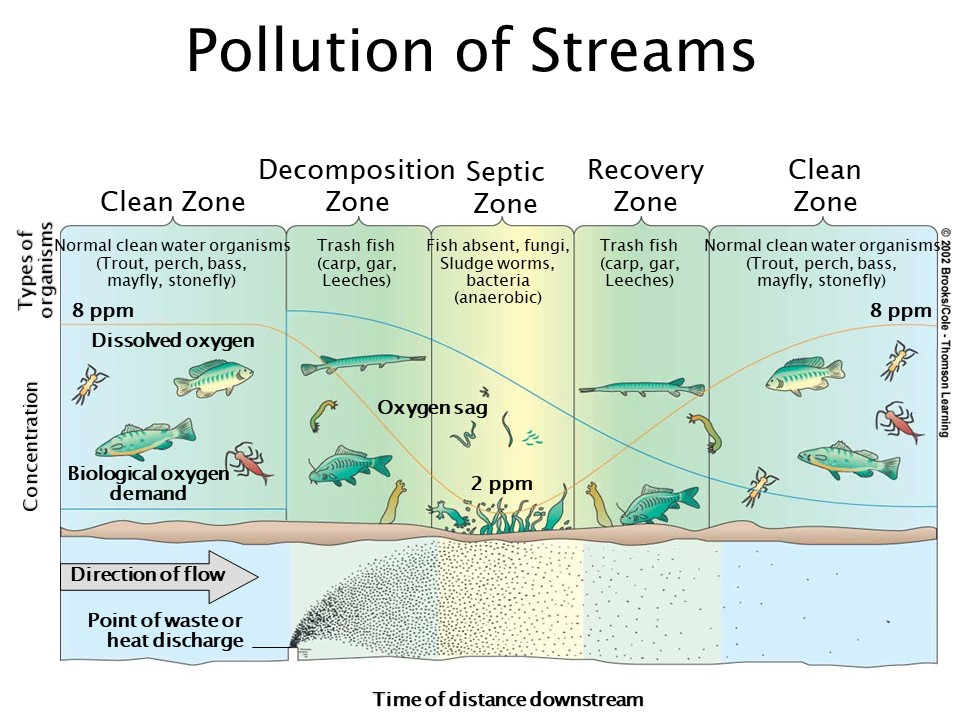
Coastal/Oceanic Water Pollution (Most affected from the input of pollutants into water systems)
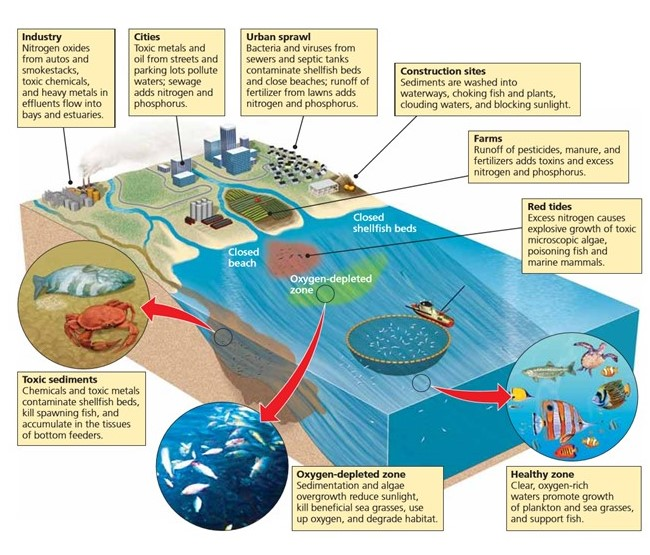
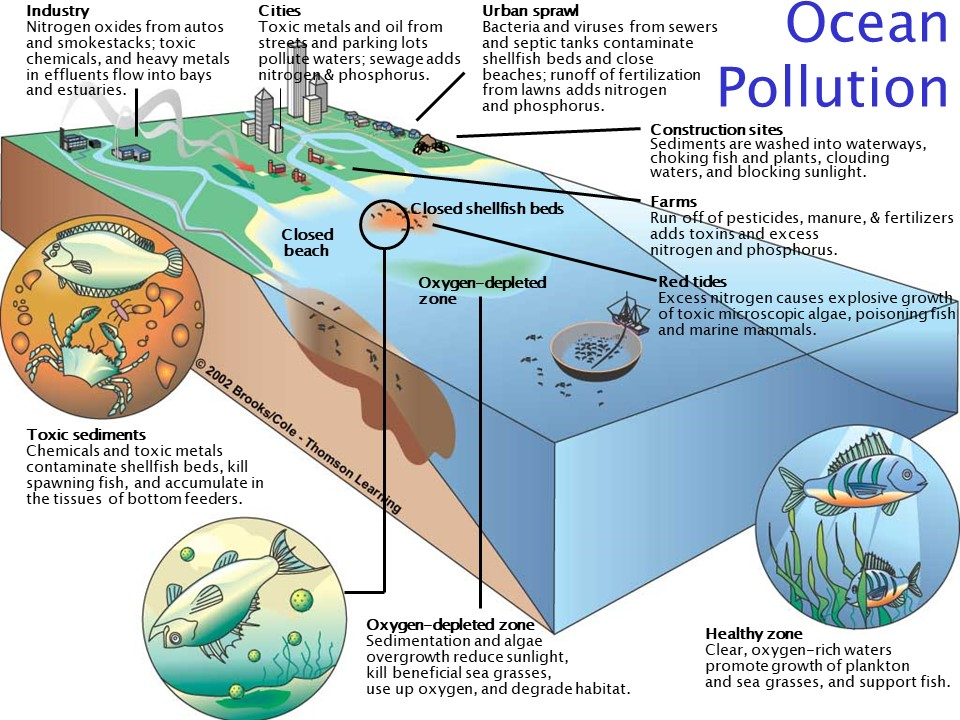
Sources of Water Pollution
Oxygen-Demanding Waste
Dead organic matter decayed and consumed by aerobic bacteria
Evaluated by Biochemical Oxygen Demand (BOD), ↑ BOD = ↑ Organic Matter
Sources: Natural Sources (Fallen Leaves), Agriculture, Urban Sewage
Pathogenic Organisms
Pathogenic microbes or microorganisms
Evaluated by level of human fecal coliform bacteria in water systems
Examples: Cholera, typhoid infections, hepatitis, dysentery, and other waterborne diseases
Nutrients
Nutrients released by human intervention, particularly phosphorus and nitrogen
May cause cultural eutrophication
Material Sources: fertilizers, detergents, and the products of sewage treatment plants
Systemic Sources: Agricultural Areas, Urban Areas
Oil
Oil discharged into surface water
Source: Oil-Tanker Accidents
Toxic Substances (heavy metals, synthetic organic chemicals, etc.)
Harmful Algal Bloom (production of algae-produced toxins via phytoplankton)
Miscellaneous (Sediments, Thermal Pollution, etc.)
Groundwater Pollution
Groundwater flows very slowly–usually less than 0.3 meters per day
Non-degradable wastes (toxic lead, arsenic, and fluoride) can take thousands of years to decompose and be removed from the system, considering them permanent pollutants
Solutions:
Extraction Wells: Pumping out contaminated water and treatment by filtration, oxidation, air stripping (volatilization of contaminant in an air column), or biological processes
Vapor Extraction: Use of vapor-extraction well and then treatment
Bioremediation: Injection of nutrients and oxygen to encourage growth of organisms that degrade the contaminant in the groundwater
Permeable Treatment Bed: Use of contact treatment as contaminated water plume moves through a treatment bed in the path of groundwater movement; neutralization of the contaminant by chemical, physical, or biological processes
Geosphere
General Characteristics
Rocks and minerals on Earth, from the molten rock and heavy metals in the deep interior of the planet to the sand on beaches and peaks of mountains
The abiotic parts of soils and the skeletons of animals that may become fossilized over geological time
Rock Cycle
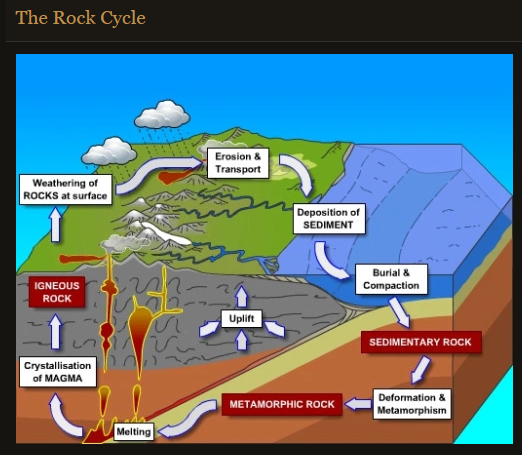
Processes such as metamorphism, melting and solidification, weathering, erosion, deposition, and burial responsible for a constant recycling of rocks on Earth
Primary Agent of Change: Earth’s Tectonic Plate Movements
Types of Rocks
Sedimentary Rocks (formed via weathering and transport of existing rocks, and then deposition, cementation, and compaction into a sedimentary rock)
Igneous Rocks (formed by the cooling and crystallization of molten rock)
Metamorphic Rocks (formed when heat or pressure are applied to other rocks)
Soil Resources: Formation and Conservation Strategies
Defining Soil
Soil Science Definition: Solid Earth material that has been altered by physical, chemical, and biological processes such that it can support rooted plant life
Geology Definition: Products of disintegration or decomposition of rocks
Soil as an Ecosystem: It comprises countless species that create a dynamic and complex ecosystem and is among the most precious resources to humans.
SOIL IS A NON-RENEWABLE RESOURCE. In theory, soil regeneration is possible for polluted or unhealthy soils. However, regeneration takes so much more time compared to pollution that soils should not be considered as a renewable resource.
Soil Characteristics
Soil Texture
Dependent on the relative proportions of sand-, silt-, and clay-sized particles
Primarily identified by estimation refined via laboratory experiments, may be guessed via the “feel” of the particle
Types of Soil Particles
Clay
Diameter of less than 0.004 mm (0.0002 in.)
Plate-like structure, cannot be dusted off if immersed in water, feels cohesive
Holds water and nutrients effectively due to diameter and structure
Silt
Diameters ranging from 0.004 to 0.063 mm (0.0002 to 0.003 in.)
Silt feels like baking flour, can be dusted off if immersed in water
Sand
0.063 to 2.0 mm (0.003 to 0.08 in.) in Diameter
Gritty feel, chunky structure
Soil Color (An indicator of organic matter content, drainage and aeration)
Black: High in organic matter (4 percent or more)
Brown: Good organic matter content and well drained.
Red: Low in organic matter, well drained. Red color is due to the presence of iron (often ferric oxide, Fe2O3).
Grey: Low in organic matter, poorly drained. Gray color is due to an excess of water and poor aeration. Gray color is due to the presence of iron (often ferrous oxide, FeO).
Yellow: Low in organic matter, well drained.
Mottling effects in subsoil: Indicates both well and poorly drained conditions during the year due to fluctuations in water table.
Soil Nutrients and Plant Nutrition (Macronutrients)
Non-Mineral Elements (Carbon [C], Hydrogen [H], Oxygen [O])
Primary Nutrients (Nitrogen [N], Phosphorus [P], Potassium [K])
Nitrogen
Building block of plant proteins, an integral part of chlorophyll and is a component of amino acids, nucleic acids and coenzymes
Taken up by plants as nitrate (NO3-) and ammonium (NH4+) ions
Phosphorus
Used to form the nucleic acids DNA and RNA and to store and transfer energy
Promotes early plant growth and root formation through its role in the division and organization of cells
Essential to flowering and fruiting and to the transfer of hereditary traits
Potassium
Necessary to plants for translocation of sugars and for starch formation
Important for efficient use of water through its role in opening and closing small apertures (stomata) on the surface of leaves
Secondary Nutrients (Calcium [Ca], Magnesium [Mg], Sulfur [S])
Soil in Agriculture
General Characteristics
The Philippines is an agricultural country with a land area of 30 million hectares, 47% of which is agricultural land
Prime agricultural lands are located around the main urban and high-population-density areas
~27% of total employment, more than half the dependent population, and about 9% of GDP (2016): account for much of the poor & vulnerable
Erosion Mitigation Measures
Contour Plowing
Plowing with the natural topography of the land
Furrows are plowed perpendicular to the slope to reduce erosion
Terracing Slopes
Produces flat areas for farming
Retaining walls of stone or other materials are used to form terraces and stabilize the slope
No-Till Agriculture
Eliminates plowing altogether, greatly reducing soil erosion
Tilling involves turning over the first 6-10 inches of soil before planting new crops
Planting of Multiple Crops
The forest trees are cut in small patches of land, and some smaller trees and plants are left in place
Several crops are planted among the remaining natural vegetation
This approach works if human population on the land is low
Climate Change and Unsustainable Land Use Practices
Effects of Climate Change
Agriculture is the most weather-dependent sector in the Philippines
More Rainfall → Land inundation and erosion; damage to crops, fisheries, livestock; Losses in agricultural inputs (seeds, fertilizers)
More Cyclone → Direct loss to crops, fisheries, and livestock; soil becomes infertile; scarcity of freshwater (irrigation)
Humid/Warm Climate → Rise in crop pests and diseases; animal diseases
Lower Rainfall → Scarcity of water irrigation; soil and nutrient deficiency
Effects of Unsustainable Land Use Practice (Land Degradation)
Reduction or loss of the biological or economic productivity and complexity of rainfed cropland, irrigated cropland, or range, pasture, forest, and woodlands
Soil erosion caused by wind and/or water
Deterioration of the physical, chemical, and biological or economic properties of soil
Long-term loss of natural vegetation